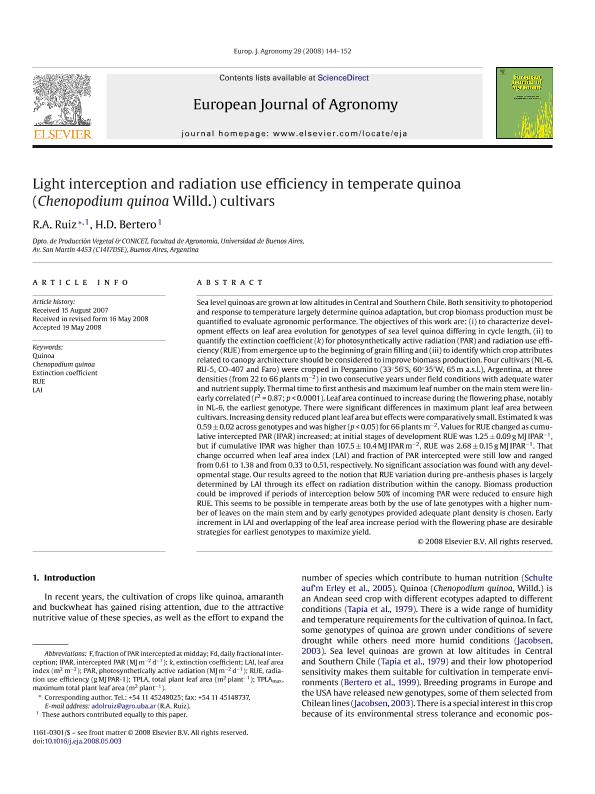Mostrar el registro sencillo del ítem
dc.contributor.author
Ruiz, Ricardo Adolfo

dc.contributor.author
Bertero, Hector Daniel

dc.date.available
2021-05-08T01:39:18Z
dc.date.issued
2008-08
dc.identifier.citation
Ruiz, Ricardo Adolfo; Bertero, Hector Daniel; Light interception and radiation use efficiency in temperate quinoa (Chenopodium quinoa Willd.) cultivars; Elsevier Science; European Journal of Agronomy; 29; 2-3; 8-2008; 144-152
dc.identifier.issn
1161-0301
dc.identifier.uri
http://hdl.handle.net/11336/131713
dc.description.abstract
Sea level quinoas are grown at low altitudes in Central and Southern Chile. Both sensitivity to photoperiod and response to temperature largely determine quinoa adaptation, but crop biomass production must be quantified to evaluate agronomic performance. The objectives of this work are: (i) to characterize development effects on leaf area evolution for genotypes of sea level quinoa differing in cycle length, (ii) to quantify the extinction coefficient (k) for photosynthetically active radiation (PAR) and radiation use efficiency (RUE) from emergence up to the beginning of grain filling and (iii) to identify which crop attributes related to canopy architecture should be considered to improve biomass production. Four cultivars (NL-6, RU-5, CO-407 and Faro) were cropped in Pergamino (33°56′S, 60°35′W, 65 m a.s.l.), Argentina, at three densities (from 22 to 66 plants m-2) in two consecutive years under field conditions with adequate water and nutrient supply. Thermal time to first anthesis and maximum leaf number on the main stem were linearly correlated (r2 = 0.87; p < 0.0001). Leaf area continued to increase during the flowering phase, notably in NL-6, the earliest genotype. There were significant differences in maximum plant leaf area between cultivars. Increasing density reduced plant leaf area but effects were comparatively small. Estimated k was 0.59 ± 0.02 across genotypes and was higher (p < 0.05) for 66 plants m-2. Values for RUE changed as cumulative intercepted PAR (IPAR) increased; at initial stages of development RUE was 1.25 ± 0.09 g MJ IPAR-1, but if cumulative IPAR was higher than 107.5 ± 10.4 MJ IPAR m-2, RUE was 2.68 ± 0.15 g MJ IPAR-1. That change occurred when leaf area index (LAI) and fraction of PAR intercepted were still low and ranged from 0.61 to 1.38 and from 0.33 to 0.51, respectively. No significant association was found with any developmental stage. Our results agreed to the notion that RUE variation during pre-anthesis phases is largely determined by LAI through its effect on radiation distribution within the canopy. Biomass production could be improved if periods of interception below 50% of incoming PAR were reduced to ensure high RUE. This seems to be possible in temperate areas both by the use of late genotypes with a higher number of leaves on the main stem and by early genotypes provided adequate plant density is chosen. Early increment in LAI and overlapping of the leaf area increase period with the flowering phase are desirable strategies for earliest genotypes to maximize yield. © 2008 Elsevier B.V. All rights reserved.
dc.format
application/pdf
dc.language.iso
eng
dc.publisher
Elsevier Science

dc.rights
info:eu-repo/semantics/openAccess
dc.rights.uri
https://creativecommons.org/licenses/by-nc-sa/2.5/ar/
dc.subject
CHENOPODIUM QUINOA
dc.subject
EXTINCTION COEFFICIENT
dc.subject
LAI
dc.subject
QUINOA
dc.subject
RUE
dc.subject.classification
Silvicultura

dc.subject.classification
Agricultura, Silvicultura y Pesca

dc.subject.classification
CIENCIAS AGRÍCOLAS

dc.title
Light interception and radiation use efficiency in temperate quinoa (Chenopodium quinoa Willd.) cultivars
dc.type
info:eu-repo/semantics/article
dc.type
info:ar-repo/semantics/artículo
dc.type
info:eu-repo/semantics/publishedVersion
dc.date.updated
2021-04-19T14:25:01Z
dc.journal.volume
29
dc.journal.number
2-3
dc.journal.pagination
144-152
dc.journal.pais
Países Bajos

dc.journal.ciudad
Amsterdam
dc.description.fil
Fil: Ruiz, Ricardo Adolfo. Universidad de Buenos Aires. Facultad de Agronomía. Departamento de Producción Vegetal; Argentina. Consejo Nacional de Investigaciones Científicas y Técnicas; Argentina
dc.description.fil
Fil: Bertero, Hector Daniel. Universidad de Buenos Aires. Facultad de Agronomía. Departamento de Producción Vegetal; Argentina. Consejo Nacional de Investigaciones Científicas y Técnicas; Argentina
dc.journal.title
European Journal of Agronomy

dc.relation.alternativeid
info:eu-repo/semantics/altIdentifier/doi/https://doi.org/10.1016/j.eja.2008.05.003
dc.relation.alternativeid
info:eu-repo/semantics/altIdentifier/url/https://www.sciencedirect.com/science/article/pii/S1161030108000622
Archivos asociados
